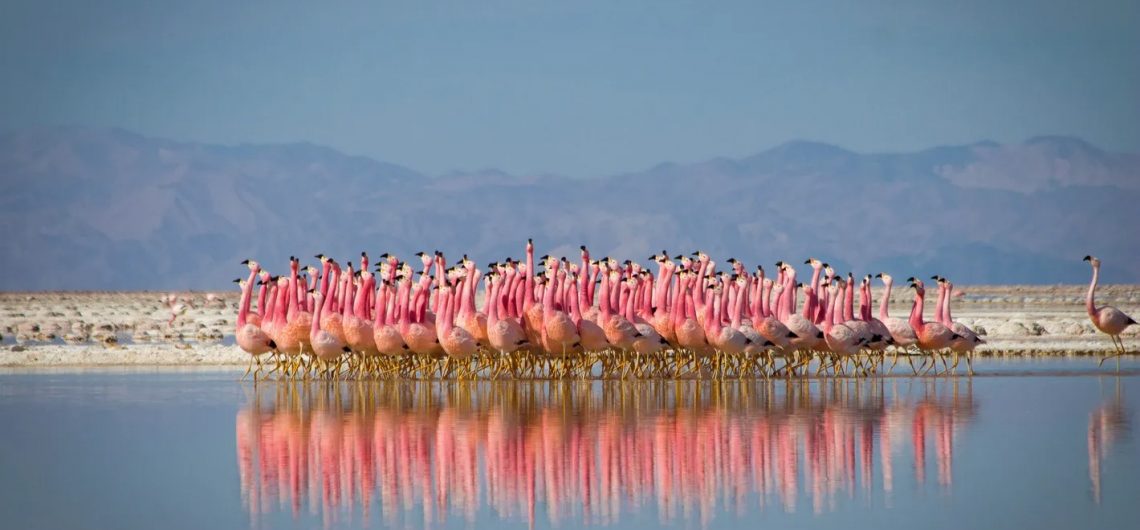Natural forces are continually modifying the globe we call home, sculpting much of the earth’s surface through volcanic eruptions like recently on Ol Doinyo Lengai and increasingly controlling our modern way of life through weather patterns.
A Perfect Planet, a new five-part BBC series that pioneers a departure from conventional natural history documentary-making, examines these powerhouses and how various species have adapted to meet their needs.
The programs, which are narrated by Sir David Attenborough, cover the ocean, the sun, the weather, the eruptions of volcanoes, and possibly the most potent force of nature in modern times: people.
Each episode contains stark climate change warnings, but there are also many vibrant animal sequences with characters who are so strange and lovely that they promise to win our hearts.
Learn about some of our favorites and how to see them in person.
Lesser Flamingos of Lake Natron and Ol Doinyo Lengai
Flamingo chicks running over Tanzania’s Lake Natron’s caustic soda flats is one of television’s most spectacular sequences, according to Sir David Attenborough, and it will live on in the memory of viewers forever. The lake, which is located beneath Tanzania’s most active volcano, Ol Doinyo Lengai, has a PH level that is approximately identical to home bleach, which deters most predators. However, adults won’t lay eggs until the lake’s center has dried up, which might happen just once every five years, making it one of nature’s most seldom sights.
According to photographer Matt Aeberhard, “Up until quite recently, more people had landed on the surface of the moon than had stood among the flamingos in the center of the Rift Valley.”
Colorful cuttlefish
This little muck dweller, which is less than 5 cm long but has a large height, is well-known for being one of the ocean’s most colorful creatures. It prefers to walk on the seafloor rather than swim since it can readily blend in with its environment by changing the texture and color of its skin. However, the super-charged suitor puts on an exciting show as a woman enters the frame, blinding his bigger lady (who is four times the size) with a jukebox of flashing lights.
“When a guy encountered a female, he went into overdrive!” says Ed Charles, who saw multiple displays while producing the Oceans episode. She frequently rebuffed his advances by squirting water in his face and scurrying away. But we had the incredible good fortune to see a female deposit eggs.
Carmine bee-eaters
When these gorgeously dressed birds fly to Zambia to lay their eggs, the arid, desolate riverbanks are decorated with their fluttering petals of sunset-red confetti. Their waterside residences were formerly a secure place to raise chicks because they were out of reach of predators, but droughts and changes in weather patterns are increasingly making them insecure.
Regarding the fast accelerating climate change, Sir David Attenborough asserts, “This is not just a little dream; we are confronting a serious disaster.”
And not just bee-eaters are in danger. The wise conservationist warns that every major city on the planet would be submerged if global warming causes the Arctic to melt.
The red crab
Think of a crab that is scared of the water. Crustaceans on the isolated Christmas Island have discovered a technique to reproduce without getting their claws too wet, which is hardly a prescription for survival. Millions of fish migrate to the shore each November during the rainy season from forests in the highlands to breed in the warm Indian Ocean waves. Selecting the ideal night — or even beach — is challenging, but the display is unmatched.
Camerawoman Sophie Darlington remembers, “We’d attempt to get a few hours’ sleep before the major event in an SUV near the spawning site. But when the occasional 4 kilogram robber crab tried to join us in the scorching heat, it frequently went into panic.
(PA)
![]()


Comments